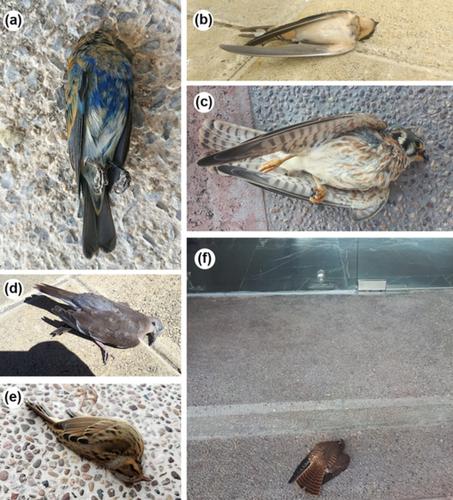当前位置:
X-MOL 学术
›
Ecol. Res.
›
论文详情
Our official English website, www.x-mol.net, welcomes your
feedback! (Note: you will need to create a separate account there.)
The invisible enemy: Understanding bird‐window strikes through citizen science in a focal city
Ecological Research ( IF 1.7 ) Pub Date : 2021-03-02 , DOI: 10.1111/1440-1703.12210 Paulina Uribe‐Morfín 1 , Miguel A. Gómez‐Martínez 2 , Lilia Moreles‐Abonce 1 , Anael Olvera‐Arteaga 1 , Harumi Shimada‐Beltrán 3 , Ian MacGregor‐Fors 4
Ecological Research ( IF 1.7 ) Pub Date : 2021-03-02 , DOI: 10.1111/1440-1703.12210 Paulina Uribe‐Morfín 1 , Miguel A. Gómez‐Martínez 2 , Lilia Moreles‐Abonce 1 , Anael Olvera‐Arteaga 1 , Harumi Shimada‐Beltrán 3 , Ian MacGregor‐Fors 4
Affiliation

|
Bird‐window collisions have been estimated to be among the most important sources of bird death. Despite increasing knowledge in Latin America, our understanding of this phenomenon is still incipient, with research performed in Mexico limited to a handful of studies. Here, we present the results of a citizen science effort focused on bird‐window collisions at seven buildings in the university campus of the National School of Higher Studies (ENES) of the National Autonomous University of Mexico, located in the city of León (central Mexico). Our main goal was to describe seasonal patterns of bird‐window collisions and their relationship with building traits (i.e., building height, window area) through citizen science monitoring strategies. Our results showed that collisions were higher in two of the seven studied buildings, with two bird species recording almost half of the total collisions: Clay‐colored Sparrow (Spizella pallida) and Indigo Bunting (Passerina cyanea). Seasonally, April was the only month to differ from the rest of the studied months, showing significantly higher rate of bird‐window collision. Regarding building traits, only building height was related to the number of recorded bird‐window collisions. In sum, our study provides findings from an understudied area, showing the value of citizen science approaches to generate knowledge on a deadly phenomenon. Notably, besides the potential drawbacks and importance of generating this kind of information, our project raised awareness on the topic across the entire campus community, from the students and academics to the administration, highlighting the potential for social impact with these kinds of projects.
中文翻译:

看不见的敌人:通过焦点城市中的公民科学了解鸟类的窗户袭击
据估计,鸟类与窗户的碰撞是鸟类死亡的最重要来源。尽管对拉丁美洲的了解有所增加,但我们对这种现象的理解仍处于起步阶段,在墨西哥进行的研究仅限于少数研究。在这里,我们介绍了一项旨在针对鸟类窗户碰撞的公民科学研究成果,该研究是在位于莱昂市(中央)的墨西哥国立自治大学的国立高等学校(ENES)的大学校园内的七栋建筑物上进行的墨西哥)。我们的主要目标是通过公民科学监测策略描述鸟类与窗户碰撞的季节性模式及其与建筑物特征(即建筑物高度,窗户面积)的关系。我们的结果表明,在研究的7座建筑物中,有2座的碰撞率更高螺旋藻(Spizella pallida)和靛蓝Bun(Passerina cyanea)。从季节上看,4月是与所研究的其余月份不同的唯一月份,表明鸟窗碰撞的发生率明显更高。关于建筑物特征,仅建筑物高度与记录的鸟窗碰撞次数有关。总而言之,我们的研究提供了一个未被充分研究的领域的发现,表明了利用公民科学方法生成关于一种致命现象的知识的价值。值得注意的是,除了生成此类信息的潜在弊端和重要性之外,我们的项目还提高了整个校园社区(从学生,学者到行政管理)对该主题的认识,并突出了此类项目对社会产生的潜在影响。
更新日期:2021-03-02
中文翻译:

看不见的敌人:通过焦点城市中的公民科学了解鸟类的窗户袭击
据估计,鸟类与窗户的碰撞是鸟类死亡的最重要来源。尽管对拉丁美洲的了解有所增加,但我们对这种现象的理解仍处于起步阶段,在墨西哥进行的研究仅限于少数研究。在这里,我们介绍了一项旨在针对鸟类窗户碰撞的公民科学研究成果,该研究是在位于莱昂市(中央)的墨西哥国立自治大学的国立高等学校(ENES)的大学校园内的七栋建筑物上进行的墨西哥)。我们的主要目标是通过公民科学监测策略描述鸟类与窗户碰撞的季节性模式及其与建筑物特征(即建筑物高度,窗户面积)的关系。我们的结果表明,在研究的7座建筑物中,有2座的碰撞率更高螺旋藻(Spizella pallida)和靛蓝Bun(Passerina cyanea)。从季节上看,4月是与所研究的其余月份不同的唯一月份,表明鸟窗碰撞的发生率明显更高。关于建筑物特征,仅建筑物高度与记录的鸟窗碰撞次数有关。总而言之,我们的研究提供了一个未被充分研究的领域的发现,表明了利用公民科学方法生成关于一种致命现象的知识的价值。值得注意的是,除了生成此类信息的潜在弊端和重要性之外,我们的项目还提高了整个校园社区(从学生,学者到行政管理)对该主题的认识,并突出了此类项目对社会产生的潜在影响。











































 京公网安备 11010802027423号
京公网安备 11010802027423号